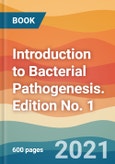Table of Contents
Outline of the Proposed Text
An Introduction to Bacterial Pathogenesis:
Molecular Mechanisms of Virulence and the Host Response
1.1. Introduction- Ecology and Epidemiology of Infection (incl. zoonoses).
2.1. Bacterial Virulence- Overview/Evolution of Pathogens
2.2. Bacterial Virulence- Adherence and Colonization
2.3. Bacterial Virulence- Invasion of Host Cells and Tissues.
2.4. Bacterial Virulence- Secretion of Virulence Factors.
2.5. Bacterial Virulence- Toxins.
2.6. Bacterial Virulence- Regulation of Virulence Factors.
2.7. Bacterial Virulence- Intracellular Pathogens.
2.8. Bacterial Virulence- Phase Variation and Biofilms
3.1. Immunity- Overview/Genetic Determinants of Susceptibility to Infection.
3.2. Innate Immunity- Normal Flora
3.3. Innate Immunity- Inflammatory Signal Transduction
3.4. Innate Immunity- Chemokines & Cytokines
3.5. Innate Immunity- Complement and Antimicrobial Peptides.
3.6. Innate Immunity- Nutritional/Metal Deprivation
3.7. Innate Immunity- Phagocytes and Oxygen-dependent Host Defenses
3.8. Adaptive Immunity- Humoral & Cellular Mechanisms
4.1. Specific Examples- Staphylococcus aureus.
4.2. Specific Examples- Coagulase-negative Staphylococci.
4.3. Specific Examples- Streptococcus pyogenes and other hemolytic streptococci.
4.4. Specific Examples- Streptococcus pneumoniae.
4.5. Specific Examples- Enterococcus.
4.6. Specific Examples- Listeria monocytogenes.
4.7. Specific Examples- Bacillus anthracis.
4.8. Specific Examples- Corynebacterium diphtheriae and diphtheroids.
4.9. Specific Examples- Escherichia coli (and sepsis).
4.10. Specific Examples- Shigella.
4.11. Specific Examples- Salmonella.
4.12. Specific Examples- Yersinia.
4.13. Specific Examples- Pseudomonas aeruginosa and related organisms.
4.14. Specific Examples- Haemophilus influenzae.
4.15. Specific Examples- Bordetella pertussis.
4.16. Specific Examples- Vibrio.
4.17. Specific Examples- Campylobacter.
4.18. Specific Examples- Helicobacter.
4.19. Specific Examples- Brucella.
4.20. Specific Examples- Francisella.
4.21. Specific Examples- Legionella.
4.22. Specific Examples- Bartonella.
4.23. Specific Examples- Neisseria.
4.24. Specific Examples- Clostridia.
4.25. Specific Examples- Bacteroides and Porphyromonas.
4.26. Specific Examples- Mycobacterium tuberculosis.
4.27. Specific Examples- Rickettsia.
4.28. Specific Examples- Chlamydia.
4.29. Specific Examples- Mycoplasma.
5.1. Conclusions- Importance of Antibiotic Resistance & Interactions with Virulence.
5.2. Conclusions- Biodefense
5.3. Conclusions- Methods of Studying Bacterial Pathogenesis
5.4. Conclusions- “Our Wits versus Their Genes” (Prospects for Future Approaches to Infection).
Footnotes.
Index








